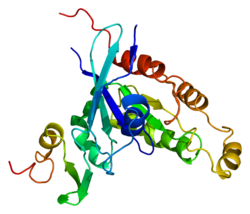PAK1
| Serine / threonine protein kinase PAK1 | ||
|---|---|---|

|
||
| according to PDB 1E0A | ||
| other names |
|
|
|
Existing structural data : 1F3M , 1YHV , 1YHW , 1ZSG , 2HY8 , 2QME , 3DVP , 3FXZ , 3FY0 , 3Q4Z , 3Q52 , 3Q53 , 4DAW , 4EQC , 4O0R , 4O0T , 4P90 |
||
| Properties of human protein | ||
| Mass / length primary structure | 545 amino acids, 60647 Da | |
| Identifier | ||
| Gene name | PAK1 | |
| External IDs | ||
| Enzyme classification | ||
| EC, category | 2.7.11.1 | |
| Orthologue | ||
| human | House mouse | |
| Entrez | 5058 | 18479 |
| Ensemble | ENSG00000149269 | ENSMUSG00000030774 |
| UniProt | Q13153 | Q9R2B2 |
| Refseq (mRNA) | NM_001128620 | NM_011035 |
| Refseq (protein) | NP_001122092 | NP_035165 |
| Gene locus | Chr 11: 77.32 - 77.47 Mb | Chr 7: 97.84 - 97.91 Mb |
| PubMed search | 5058 |
18479
|
PAK1 is an enzyme that is encoded by the PAK1 gene and belongs to the serine / threonine protein kinases . This enzyme family of serine / threonine kinases is important in signal transduction and for various parts of cell regulation. PAK1 also belongs to the family of p21-activated kinases , which are generally divided into two subfamilies - groups 1 and 2, the division being based on the structure of the various domains and the regulation. The first group includes PAK1, PAK2 and PAK3 , all of which bind to the GTP-linked Rho-GTPases CDC42 and RAC1 . The second group, however, PAK4 , PAK5 and PAK6 , are independent of the Rho GTPases.
function
The functions of the enzyme are varied. It is involved in intercellular signal transport processes of integrins and receptor kinases , which play an important role in the cytoskeleton , and also in cell migration , cell adhesion , proliferation , apoptosis , mitosis , gene transcription , the control of the cell cycle and vesicle transport processes.
The p21-activated kinase 1 phosphorylates and activates MAP2K1 and thereby influences the activity of other MAP kinases , phosphorylates TBCB and is thus involved in the regulation of the formation of microtubules and their organization and phosphorylates MYL9 / MLC2 and RAF1 at the amino acids Ser338 and Ser339 , which leads to the activation of RAF1 with subsequent migration of RAF1 to the mitochondria , phosphorylation of BAD by RAF1 and binding of RAF1 to BCL2 . It also participates in the reorganization of the actin - cytoskeleton , the actin fibers in the focal adhesion and on the distribution of insulin .
PAK1 is inhibited by apoptosis, probably because of binding to CDCL1 and CDCL2 .
Interaction with other proteins
The p21-activated kinase 1 interacts with ARHGEF2 , CDC42 , CDK11B , CRIPAK , GIT1 , LIMK1 , NCK2 , RAC1 and RHOU .
Animal model
If PAK1 or PAK3 is inactivated, this has only moderate consequences in mice. Only the simultaneous inhibition of PAK1 and PAK3 leads to healthy born mice, but to severe defects in further brain development, which is due to reduced neuronal cell volume, a reduced number of axons and dendrites and a reduced synapse density . The mice then showed their behavior to be hyperactive and anxious and showed learning deficits; the electrophysiological activity in the hippocampus was abnormal and the activity of cofilin at the synapses was increased.
Individual evidence
- ↑ a b c d e UniProt Q13153
- ↑ a b PAK1. In: Online Mendelian Inheritance in Man . (English)
- ↑ J. Eswaran, M. Soundararajan, R. Kumar and S. Knapp: UnPAKing the class differences among p21-activated kinases . In: Trends in Biochemical Sciences . 33, No. 8, August 2008, pp. 394-403. doi : 10.1016 / j.tibs.2008.06.002 . PMC 18639460 (free full text).
- ↑ J. Nie, C. Sun, O. Faruque, G. Ye, J. Li, Q. Liang, Z. Chang, W. Yang, X. Han and Y. Shi: Synapses of amphids defective (SAD-A) kinase promotes glucose-stimulated insulin secretion through activation of p21-activated kinase (PAK1) in pancreatic β-cells . In: Journal of biological chemistry . 287, No. 31, July 2012, pp. 26435-26444. doi : 10.1074 / jbc.M112.378372 . PMID 22669945 . PMC 3406726 (free full text).
- ^ S. Asrar, Y. Meng, Z. Zhou, Z. Todorovski, WW Huang, Z. Jia: Regulation of hippocampal long-term potentiation by p21-activated protein kinase 1 (PAK1). In: Neuropharmacology. Volume 56, Number 1, January 2009, pp. 73-80, doi : 10.1016 / j.neuropharm.2008.06.055 , PMID 18644395 .
- Jump up ↑ J. Meng, Y. Meng, A. Hanna, C. Janus, Z. Jia: Abnormal long-lasting synaptic plasticity and cognition in mice lacking the mental retardation gene Pak3. In: The Journal of neuroscience: the official journal of the Society for Neuroscience. Volume 25, number 28, July 2005, pp. 6641-6650, doi : 10.1523 / JNEUROSCI.0028-05.2005 , PMID 16014725 .
- ↑ W. Huang, Z. Zhou, S. Asrar, M. Henkelman, W. Xie Z. Jia: p21-Activated kinases 1 and 3 control brain size through coordinating neuronal complexity and synaptic properties . In: Molecular and cellular biology . 31, No. 3, February 2012, pp. 388-403. doi : 10.1128 / MCB.00969-10 . PMID 21115725 . PMC 3028630 (free full text).